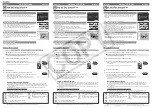
Backup Overview
36 Agent for Microsoft SQL Server Guide
Log Truncation Options
Log Truncation Options are accessible from the Database Level/Agent Options
and Global Options/Agent Options dialogs:
■
Remove inactive entries from transaction log, after
backup--
(Truncation) Truncates the Transaction Log files, removing entries
included in the backup so that the space in the files can be reused. This is the
default option.
■
Do not remove inactive entries from transaction log, after
backup--
(No truncation) Retains backed up log entries after backup. These
entries will be included in the next Transaction log backup.
■
Back up only the log tail and leave the database in unrecovered
mode--
(No recovery) Backs up the log and leaves the database in a
restoring state. This option is available for Microsoft SQL Server 2000 or
later. Use this option to capture activity since the last backup and take the
database offline prior to restoring or repairing it.
The Log Truncation Options are available only when the selected Backup
Method is Transaction Log, or when the Backup Transaction Log After
Database option is checked.
Important!
Do not use the "Backup only the log tail and leave the database
in unrecovered mode" log truncation option to back up the ARCserve
Database. Performing a backup with this option causes the database to be
placed in an offline status, and you can lose the ability to find the backups of
the ARCserve Database in order to perform a restore and bring the database
online. If you perform a backup of the ARCserve Database using this option,
you can use ARCserve Database Recovery Wizard to recover the CA
ARCserve Backup database and bring it back online.
Log Truncation Options are not affected by the Override Global Options setting
on the Database Level Agent Options dialog. If Transaction Log or Backup
Transaction Log After Database is selected for the database, the database Log
Truncation Options are used.
Database Consistency Check (DBCC) Options
A database consistency check (DBCC) tests the physical and logical consistency
of a database. DBCC provides the following options:
■
Before Backup--
Checks consistency before the backup of the database.
■
After Backup--
Checks consistency after the backup of the database.
■
Continue with backup, if DBCC fails--
Performs a database backup even
if a consistency check before backup reports errors.
















































